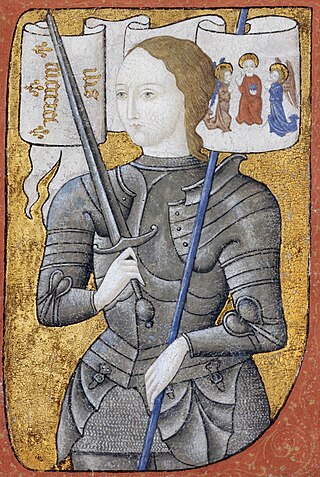
Joan of Arc is a patron saint of France, honored as a defender of the French nation for her role in the siege of Orléans and her insistence on the coronation of Charles VII of France during the Hundred Years' War. Claiming to be acting under divine guidance, she became a military leader who transcended gender roles and gained recognition as a savior of France.

Alexandre Cabanel was a French painter. He painted historical, classical and religious subjects in the academic style. He was also well known as a portrait painter. According to Diccionario Enciclopedico Salvat, Cabanel is the best representative of L'art pompier, and was Napoleon III's preferred painter.
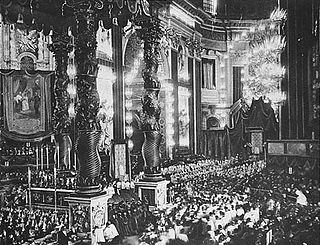
Joan of Arc (1412–1431) was formally canonized as a saint of the Roman Catholic Church on 16 May 1920 by Pope Benedict XV in his bull Divina disponente, which concluded the canonization process that the Sacred Congregation of Rites instigated after a petition of 1869 of the French Catholic hierarchy. Although pro-English clergy had Joan burnt at the stake for heresy in 1431, she was rehabilitated in 1456 after a posthumous retrial. Subsequently, she became a folk saint among French Catholics and soldiers inspired by her story of being commanded by God to fight for France against England. Many French regimes encouraged her cult, and the Third Republic was sympathetic to the canonization petition prior to the 1905 separation of church and state.

Jules Bastien-Lepage was a French painter closely associated with the beginning of naturalism, an artistic style that emerged from the later phase of the Realist movement.
Joan of Arc (1412–1431) was a French woman who is known for her role in the Hundred Years' War and as a religious figure.
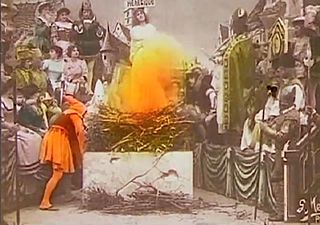
Joan of Arc is a 1900 French silent film directed by Georges Méliès, based on the life of Joan of Arc.
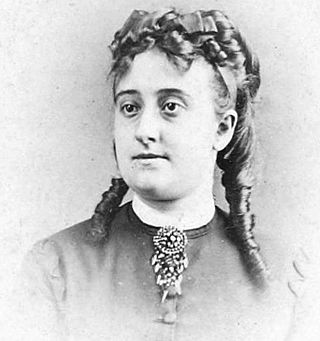
Eva Gonzalès was a French Impressionist painter. She was one of the four most notable female Impressionists in the nineteenth century, along with Mary Cassatt (1844–1926), Berthe Morisot (1841–95), and Marie Bracquemond (1840–1916).

Joan of Arc has inspired artistic and cultural works for nearly six centuries. The following lists cover various media to include items of historic interest, enduring works of high art, and recent representations in popular culture. The entries represent portrayals that a reader has a reasonable chance of encountering rather than a complete catalog. Lesser known works, particularly from early periods, are not included. In this article, many of the excluded items are derivative of better known representations. For instance, Friedrich Schiller's 1801 play The Maid of Orleans inspired at least 82 different dramatic works during the nineteenth century, and Verdi's and Tchaikovsky's operatic adaptations are still recorded and performed. Most of the others survive only in research libraries. As another example, in 1894, Émile Huet listed over 400 plays and musical works about Joan of Arc. Despite a great deal of scholarly interest in Joan of Arc, no complete list of artistic works about her exists, although a 1989 doctoral dissertation did identify all relevant films including ones for which no copy survives.
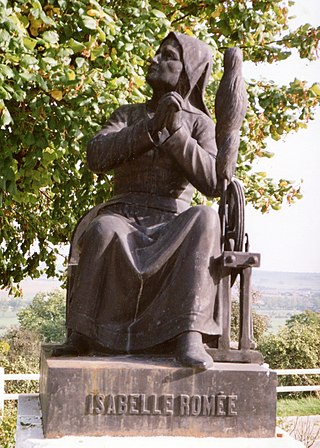
Isabelle Romée, also known as Isabelle de Vouthon and Isabelle d'Arc (1377–1458) and Ysabeau Romee, was the mother of Joan of Arc. She grew up in Vouthon-Bas and later married Jacques d'Arc. The couple moved to Domrémy, where they owned a farm consisting of about 50 acres (200,000 m2) of land. After their daughter's famous exploits in 1429, the family was granted noble status by Charles VII in December of that year. Isabelle moved to Orléans in 1440 after her husband's death and received a pension from the city. She petitioned Pope Nicholas V to reopen the court case that had convicted Joan of heresy, and then, in her seventies, addressed the opening session of the appellate trial at Notre Dame cathedral in Paris. The appeals court overturned Joan's conviction on 7 July 1456. Isabelle died two years later, probably at Sandillon near Orléans.
Pierronne, also known as Pierrone, Pierronne la Bretonne and Perrinaïc, was a Breton woman who said she saw visions of "God dressed in a long white robe with a red tunic underneath". Pierronne, who may have met Joan of Arc in 1429, tried to defend her reputation at Corbeil. For this, Pierronne was arrested by pro-English authorities in March 1430 and burned at the stake.

Louis-Joseph-Raphaël Collin was a French painter born and raised in Paris, where he became a prominent academic painter and a teacher. He is principally known for the links he created between French and Japanese art, in both painting and ceramics.

Due to inconsistent record keeping and different contemporary customs, the name of Joan of Arc at birth is not known for certain.

Jacquesd'Arc was a farmer from Domrémy, France who was the father of the French military leader and Catholic saint Joan of Arc. D'Arc is most known for being an influence on his daughter Joan's life, developing her leadership abilities through his example as a local government and military leader as well as restricting her ambitions with his controlling behaviour that resulted in a strained relationship between them.
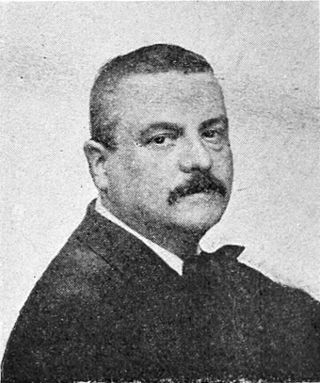
Lionel-Noël Royer was a French painter. He was most famous for painting large scenes of the life of Joan of Arc in the Basilica of Bois-Chenu in Domrémy.

Louis-Maurice Boutet de Monvel was a French painter and illustrator best known for his watercolours for children's books. He was a major figure in nineteenth-century children's book illustration.

Jeanne d'Arc is an 1874 French gilded bronze equestrian sculpture of Joan of Arc by Emmanuel Frémiet. The outdoor statue is prominently displayed in the Place des Pyramides in Paris.

Alfred Guillou was a French painter of Breton heritage.

A Young Lady in 1866 or Lady with a Parakeet is an 1866 painting by Édouard Manet, showing his favourite model Victorine Meurent, wearing a pink gown, holding a small bouquet of violettes and accompanied by an African Grey Parrot. It is an oil painting on canvas measuring 185.1 x 128.6 cm, and is now in the Metropolitan Museum of Art in New York. It and Boy Carrying a Sword were the first of Manet's works to enter a gallery collection.

Haymaking or Resting in the Fields is an 1877 painting by Jules Bastien-Lepage. First exhibited at the 1878 Paris Salon, it was acquired by the Musée du Luxembourg in 1885 at the posthumous sale of the artist's works. It passed to the Louvre in 1929 and then to its current home in the Musée d'Orsay, in Paris, in 1980.

October is an 1878 painting by Jules Bastien-Lepage, now in the National Gallery of Victoria, in Melbourne. It is also known as Picking Potatoes, The Potato Gatherers or Woman Gathering Potatoes.


















